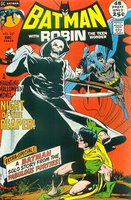Like many comic fans, I've been reading comics as long as I can remember.
 Batman #237 (at right) stands out as one of the earlier books that attracted my attention, and it's THE example of why I enjoy the comics medium. In the first place, it's got a fairly high pedigree -- it was written by Denny O'Neil, based on some ideas from Harlan Ellison, and it was drawn by Neal Adams and Dick Giordano. So it shouldn't come as a surprise that the story is fairly well-executed.
Batman #237 (at right) stands out as one of the earlier books that attracted my attention, and it's THE example of why I enjoy the comics medium. In the first place, it's got a fairly high pedigree -- it was written by Denny O'Neil, based on some ideas from Harlan Ellison, and it was drawn by Neal Adams and Dick Giordano. So it shouldn't come as a surprise that the story is fairly well-executed.The story is self-contained and revolves around Batman tracking a murderer to a Halloween party. Not just any Halloween party, though, but one of Tom Fagan's legendary Halloween parties. Fagan was a huge comic book fan in the 1960s and 70s and held a costume party once a year that began with a parade through Rutland, VT and ended at his house where everyone in attendance dressed up as comic book characters. The party was attended by the biggest comic book fans of the period and a number of comic book professionals, including Roy Thomas, Marv Wolfman and Wendy Pini. What struck me was that, in the comic, a great many guests are seen in costume: Superman, Batman and Captain Marvel, naturally, but also Spider-Man and Thor. (Well, legal near-approximations of them, anyway.) So, despite the fact that Batman and Robin were the only actual heroes in the book, it was clear to me that they all inhabited the same universe and, more significantly, they were known by "normal" people like Tom Fagan. It occurred to me that each comic book was a window into a small portion of a larger world. In one title, I might see Batman; in another, I could see Aquaman; and in another, the Green Arrow. There was even a fourth book -- Justice League -- in which I could see where those worlds intersected! Captivating stuff!
Many years later, I'm still peeking into those windows and seeing what's happening on those other worlds. But in my attempt to truely appreciate what I read, I've spent a great deal of time studying the medium itself as well as its history. What did Windsor McCay contribute to later comic artists? What impact did the Comics Code really have on the industry? What were the influences on Stan Lee and Jack Kirby that helped shape the Fantastic Four? How does today's editor-in-chief positions differ from the editor-in-chief positions from 20, 30, 40 years ago?
So that, in a nutshell, is where I'm coming from. I've run a blog before, but it was more of a stream-of-consciousness piece with comments ranging on every subject imaginable. With "Kleefeld on Comics", I'd like to use this as a forum to discuss some of my thoughts and ideas about my favorite medium where I don't otherwise have a readily available outlet.






1 comments:
Sean - what a cool-sounding comic, and what a great introduction to the new blog! I always thought of metafictional references as more of a Marvel thing, but this Batman and Robin comic seems right up there with that Impossible Man issue of the FF where the heroes end up battling in the Marvel bullpen. Sounds like you were hooked by a classic!
Post a Comment